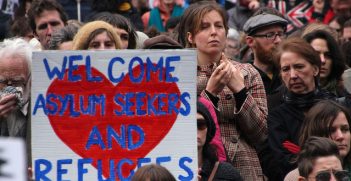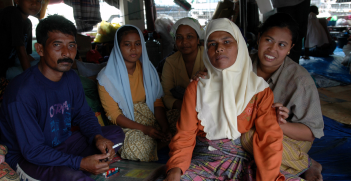The Politics of (In)visibility: Novak Djokovic and Australia’s Endless “Border Crisis”

Djokovic’s case is another episode in Australia’s obsession with the border crisis. It raises important questions about who manufactures this “crisis” language, and for what purposes.
Over the last few weeks, we have been waking up to the news about the world’s number one tennis player, Novak Djokovic. None of us would have thought that Djokovic’s name would appear in debates about Australia’s border and detention regime. Australians are now familiar with Djokovic’s case, and the criticisms about his exemption from the COVID-19 vaccination, visa cancellation, and his detention at the Park Hotel Melbourne, where several refugees are currently detained. His case has drawn attention to Australia’s arbitrary border regime, particularly to the immigration minister’s unlimited power and the use of hotels as “alternative places of detention” for refugees and asylum seekers.
Djokovic’s case is yet another episode in Australia’s obsession with the border crisis. It is not so much the border itself, but the “crisis” language that is a key element of Australian politics. Anything can be turned into a border crisis in Australia. I call this relentless effort of manufacturing crises “border theatre” — a sovereign act that turns a state’s border into a theatrical performance, where narratives and myths about a nation can be produced. This sovereign performance first creates categories of illegality, and then makes those categories visible for the audience to consume. The key narrative circulated through this performance is “our strong, sovereign borders,” which allows the sovereign to display its power.
In this narrative, the border appears as a defensive line — a fortified line — that needs to be protected against an enemy, who can be given any name at any time. Australia is constantly at war. Nicholas De Genova calls this performance the “border spectacle,” which “sets a scene” of border enforcement, normalises it and turns “illegality” into a natural category to be circulated through the national consciousness. Anyone can be the subject of this spectacle or invited as an audience. The boundaries between the spectator and the performer slowly disappear, and anywhere can be transformed into a border site. Borders are not static administrative lines on the map. Rather, they are socially, culturally, and politically produced sites. We are all active participants in this performance.
There is much to be discussed about Djokovic’s case. One important aspect of this case is certainly the minister’s authority to define what constitutes the “public interest” and their absolute and almost unquestionable power to make any decisions about Australia’s border spectacle. Immigration Minister Alex Hawke’s second cancellation of Djokovic’s visa, “on health and good order grounds, on the basis … [of] the public interest” was based on his power under section 133C(3) of the Migration Act 1958. This decision came after the Federal Circuit and Family Court of Australia challenged his prior cancellation. According to Djokovic’s lawyer, the minister had cancelled the visa because Djokovic could incite, “anti-vax sentiment” in the community.” Such pre-emptive reasoning not only sets a dangerous example but shows that a key objective of creating constant border crises in Australian politics is keeping borders in a permanent “state of exception.” This practice increasingly normalises crisis language, blurs the distinction between “emergency” and “normal” politics, and eventually, changes perceptions about what constitutes the public interest and who has the ultimate authority to define it.
However, what interests me most about this case is the politics of (in)visibility — specifically, how has Djokovic’s case highlighted ongoing mobility inequalities and injustices? And what does the widespread global and national publicity (and thereby hyper-visibility) of the world’s number one tennis player tell us about our blindness and silences towards border violence against refugees and asylum seekers? The most critical question we need to ask ourselves about Djokovic’s case is: whose stories are made visible, and whose stories are completely forgotten?
The Missing Migrants Project has recorded 46,335 border-related deaths since 2014, with 5,279 deaths in 2021 alone. In September 2021, the United Nations’ Our Common Agenda: Report of the Secretary-General stressed the growing humanitarian crisis, and called for collective action. In my recent work, I showed how the COVID-19 pandemic has worsened the suffering of refugees and asylum seekers. Those who were already excluded from the global mobility regime before the pandemic have now become completely invisible. Despite the seriousness of the current situation, the dreadful conditions of refugee camps in Europe, the closed border policy towards refugees and asylum seekers, and the violent consequences of these policies hardly make headlines. Refugees and asylum seekers are made visible only through state performances, which depict them as “illegal trespassers of our sovereign borders” and “queue jumpers.” The production of invisibility is not an innocent practice. It is the constitutive element of a border spectacle. It shapes public attention, makes the suffering of people in need imperceptible, and normalises their suffering. The production of invisibility hides ongoing violence, injustices, and inequalities.
Djokovic’s case has undoubtedly raised awareness of the detention of refugees in hotels through Australia’s border regime. Some have commented that such publicity about his case and his detention in the same hotel in which refugees are detained could be destructive for Australia’s international public image. But, as Behrouz Boochani wrote, “in a better world, public anxieties about international image would be stirred by the imprisonment of refugees in the same hotel.” Indeed, why do we need a celebrity — his hyper-visibility — to become concerned about these makeshift immigration detention sites? Using hotels as part of Australia’s border enforcement regime is not new. The practice has been repeatedly criticised by human rights groups and refugee activists. In February 2020, the Commonwealth Ombudsman raised concerns about the increased use of these sites for longer periods. Similarly, in a recently published review, Management of COVID-19 Risks In Immigration Detention, the Australian Human Rights Commission recommended that the Department of Home Affairs and the Australian Border Force decommission the use of hotels for closed detention, and noted:
Given the limited space and facilities available in hotel APODs, restrictions on offsite appointments and excursions introduced in response to COVID-19 would be especially harsh and restrictive for people detained in hotel APODs. The Commission has consistently found that hotels are not appropriate places of closed immigration detention, given their lack of dedicated facilities for exercise, recreation and activities and limited access to outdoor space.
There is nothing luxurious about these hotels. They are part of Australia’s punitive border regime and its treatment of asylum-seekers as “bodies-in-transit,” who are not considered worthy of its protection. For refugees, time is frozen in these border sites. And the Australian government continues to weaponise such uncertainty against refugees and asylum seekers as part of its border deterrence strategy.
Thankfully, Djokovic’s detention at one of these hotels has made the ongoing situation visible even for a usually disinterested audience. It has provided an opportunity for refugee activists and refugees to reveal the conditions of these hotels and the cruelty and arbitrariness of Australia’s refugee detention regime as a whole. The recent episode of Australia’s border theatre has shown us the power of refugees in making themselves visible. It has demonstrated their ability to turn themselves into what I call “noisy-subjects.” Their noise exposes the limits of the state’s power in determining the entire narrative of the border spectacle. Their noise tells us that Australia’s border regime is neither legally nor morally sustainable. It shows us that there is nothing self-evident about borders. We do not have the same privileges of mobility and visibility; our passports define the limits of our freedoms. Therefore, their noise also acts as a reminder of our own privileges, our blindness, and our silences as spectators of Australia’s never-ending border crisis.
Umut Ozguc is a Lecturer in International Relations and Politics at Deakin University, Australia. Her research expertise is security and border politics. Her work examines the construction of borders in settler-colonial states.
This article is published under a Creative Commons License and may be republished with attribution.





